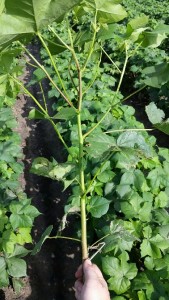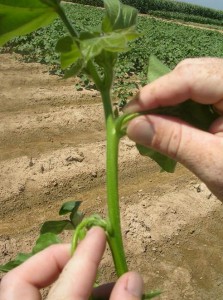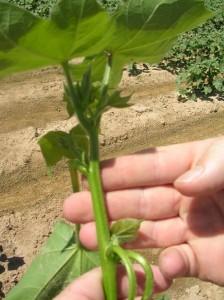by Gaylon Morgan and Mark Kelley
Much of Texas’ cotton was planted at or very near the final planting date for within each region of the state. These delayed plantings have equated to one of the latest Texas cotton crops we have seen in many years. Additionally, much of South and East Texas has been further delayed by excessive rain delaying fruit set. This article will address some of the considerations for plant size management and promoting early maturity in the 2015 growing season. The University of Georgia publication titled “Use of PGRs as a Management Tool in Cotton” has a good publication discussing the importance of PGR, physiological role, and recommendations. Additionally, Cotton Incorporated’s publication titled “Utility of Plant Growth Regulation in Cotton Production” provides a Beltwide summary of the PGRs’ impact on maturity, height, and height.
South and East, Texas Considerations:
In South and East Texas, the benefits of PGRs (plant growth regulators) is on plant size management, because sufficient time (heat units) exist to finish out the cotton. However, any benefit on increasing maturity will be welcomed to decrease the risk adverse weather (or hurricanes) in the fall. Thus far, excessive rainfall and cloudy weather has substantially reduced fruit retention, further delaying the crop, and causing shading effects. See Figure 1 below. With poor fruit load, PGR (plant growth regulators) management will be necessary later into the season than most years. PGRs applications timings should be based on growth stage (reproductive), fruit load, plant size, and expectation for continued vigorous growth. With the loss of the first multiple fruiting positions in some fields, PGRs will be applied on much bigger plants this year. The balance this year will be the trying to compress plant growth (decrease internode length) of large plants without retarding plant growth (and yield) too much. Especially this year, PGR application should be made on a field-by-field basis due to the extreme variability between fields.
With cotton beyond the early bloom stage and internode length (average of top 5 nodes) beyond 2.25 inches, a PGR application is warranted. However, for cotton plants that are currently or recently recovering from the stress of saturated conditions, high rates of PGR should be avoided. The combination of stress + high PGR rates could prematurely send the crop into the cut-out stage and would likely reduce yields. The best approach is to apply multiple applications of a moderate PGR rate, such as 8 oz/a of mepiquate chloride, and assess the situation.

Figure 1. A 10+ nodes cotton plant from Upper Gulf Coast with a very low boll load. Picture compliments of Dr. Zach Eder.
Rolling and High Plains Considerations:
In the Rolling Plains and High Plains, PGR applications should be considered for two reasons this season. First, PGRs can be beneficial in promoting earliness by promoting early fruit set. Second, PGRs can be helpful in managing plant size for stripper harvested cotton, if excessive moisture continues or under full irrigation in the West Texas. See Figure 2 below. The goal of PGR applications is to slow cotton growth until the boll load naturally slows the vegetative growth. However, PGRs should not be applied to plants that are already under stress from moisture, spider mites, herbicide, or nutrient. Also, applications should not be made prior to 50% matchhead square. Assuming no stress, decision to apply PGRs should be dependent on several factors, including the current growth (internode length), fruit retention, current and predicted weather (precipitation and heat), variety, and soil nitrogen levels.
Fields with low fruit set, excellent moisture, high soil nitrogen, and vigorous growing varieties are the prime candidates for PGRs and should be watched carefully for excessive vegetative growth. In addition to size management, sequential applications of low to moderate rates of PGRs have shown to reduce about 1 main stem node, which results in 3 to 5 day earlier cutout. This promotion of earliness could be a big advantage in 2015. Also, a 5 to 20% reduction in plant height can be typically be obtained from PGR applications (Boman and Kelley, 2007).
As mentioned in a publication titled (Plant Growth Regulators) by Randy Boman in 2007, PGRs decisions in West Texas are challenging. High temperatures, high winds, and low humidity will slow plant growth, especially in low irrigation capacity fields. So, using the weather forecast should also contribute to the decision on PGR applications and rates.

 Cotton plant not treated (left) with PGR and cotton treated (right) with PGR at pinhead square. Notice the reduction in internode length of the mainstem.
Cotton plant not treated (left) with PGR and cotton treated (right) with PGR at pinhead square. Notice the reduction in internode length of the mainstem.
Other useful information can be found at the links below.
1. PGR Management Considerations (in North Carolina) by Collins and Edmisten

Dr. Gaylon Morgan
State Extension Cotton Specialist
College Station, TX
979-845-2425
gmorgan@tamu.edu